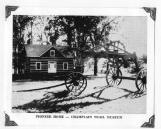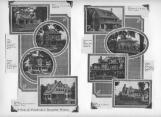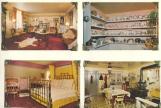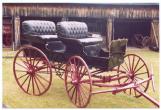1
Champlain Trail Museum, in Pembroke, Ontario, post 1965.1865
Champlain Trail Museum and Pioneer Village, Pembroke, Ontario, Canada

2
This view of the Champlain Trail Museum serves as an introduction to a short look at the social and historical context of the era covered by the fashion shows that were presented by the Ottawa Valley Historical Society in 1998 and 1999.3
Pembroke was a cosmopolitan centre on the Ottawa River, and on a trans-continental railway line after 1876. It was the commercial centre for Renfrew County and the Pontiac, as well as the county seat. Electrical power was available by 1884. Other pluses were: proximity to the military base at Petawawa (founded 1905); access to the hinterland of agriculture and forestry; and its relatively close proximity to Ottawa, via railway and the river. Its relative isolation from other urban centres as the only major settlement on the Ottawa River above Ottawa ( its only "rival" was Renfrew, possibly Chapeau), and its status as a major river port with access to the Upper Valley also placed it in a favourable position vis-a vis commercial development.4
Here are some interesting facts about forestry, the Ottawa Valley's main industry:From: The Way It Was in the Ottawa Valley, by Brenda Lee-Whiting (Townsend Books, 1992)
-1892 - sawmills owned by "lumber baron" J.R. Booth turned out 140,000 board feet of pine lumber, more lumber than any other company in the world;
- Booth leased timber limits of more than 4000 sq. miles in Ontario and Quebec - was the largest operator of forest harvest in the British Empire;
- 1896 - 17 lumber companies operating on the Ottawa River;
- lumber companies began operations in Bytown (Ottawa) earlier in the 19th century, then moved operations farther up Ottawa River, closer to the pineries;
- Pembroke was 100 miles nearer the timber harvests, and quickly became a supply centre for equipment and food;
- 1976 - Pembroke still had 4 industries based on forestry. An Ontario government report concluded that county's economy had not found a replacement for the lumber trade, that declined in the early 20th century.
Clearly, the late 19th and early 20th centuries were prosperous times in the Upper Ottawa Valley. A major industry of the time was centred here, and contributed greatly to the social environment that we see through the fashions on display.
5
The local commercial scene was very vibrant, as many entrepreneurs opened businesses to serve the many needs of the lumber trade. This is evident from this quotation taken from the Pembroke Women's Institute Tweedsmuir History:"James O'Kelly, born in 1869, is most well remembered by older Pembroke residents as he remained here and established a cigar factory at the corner of Pembroke and Alexander streets. He put many brands of cigars on the market but "The King" cigar remained the favourite. During the 1880's he had branch offices in Winnipeg and Calgary. In connection with his cigar house, he also conducted a wholesale liquor business, being the only direct wine and spirit importer having a customs bonded warehouse in the Ottawa Valley. He was the owner of some outstanding harness racing horses, and O'Kelly Park, where horse races were held for years in Pembroke."
7
"Pembroke is widely noted as a town of beautiful residences and in that respect has no superior in Canada."From "Pembroke, Canada's Next City", by Desmond Morris, 1915.
9
Pembroke has 8 churches, a convent, public and separate schools, a high school, business college, courthouse, jail, town hall, two movie theaters, a large opera house, drill hall, large skating rink, curling rink, 3 banks (Royal, Ottawa, and Quebec), a Carnegie Free Library, up-to-date stores, and 3 newspapers.From "Pembroke, Canada's Next City", by Desmond Morris, 1915.
11
As shown by the quotation below, which is perhaps equal parts promotion and fact, the economic atmosphere of Pembroke during the period when our fashions graced its streets and hotels, attracted many people to set up residence here."Both for business purposes and residential purposes Pembroke is a most desirable town. Because of its advantageous surroundings, its commercial facilities, its advantages as a shipping and distributing point, its excellent sanitary conditions, and the thousand and one things that make the town a desirable place in which to live, it has attracted, during the past few years, capitalists and business men from afar.
The district surrounding Pembroke is one of the richest agricultural districts in Eastern Canada. The farmers are all well-to-do, while many of them have accumulated fortunes."
From "Pembroke, Canada's Next City", by Desmond Morris, 1915
13
This buggy, called a democrat, was owned by a Lutheran preacher, the Reverend Ludwig Herman Gerndt, who has been credited with the founding of most of the Lutheran churches in Renfrew County between 1861 and 1870.It would be similar to the transportation used by many of the people who wore the fashions displayed in these shows.
Recently refurbished, this democrat is on display at the Champlain Trail Museum and Pioneer Village in Pembroke, Ontario.



